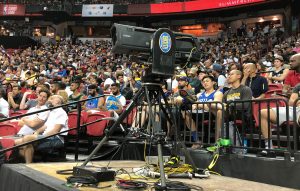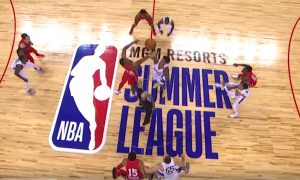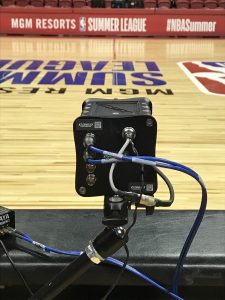ESPN’s NBA Summer League Operation Grows by Leaps and Bounds
The production now covers 82 games, next-gen tech
Story Highlights
ESPN’s production at this year’s NBA Summer League in Las Vegas was almost unrecognizable compared with just a few years ago. With all 30 teams participating for the first time, ESPN’s presence in Vegas has grown from a small, four-camera show to a massive production of all 82 Summer League games (July 6-17) across ESPN, ESPN2, ESPN3, ESPNU, and the ESPN App featuring more than six cameras and a full arsenal of next-gen technology, including a SkyCam system. In addition, ESPN worked with the league to create innovative alternative viewing experiences on ESPN3 and the ESPN App.
“Our operations team continues to rise to every challenge,” says ESPN Operations Manager Patty Mattero. “I am extremely proud of the teamwork and accomplishments, especially this year. Logistical planning starts early, but, on the coattails of NBA Finals, the last leg of decisions can be a crunch. We continue to be as cost-effective as possible by implementing a detailed game-rotation work schedule for all technical crews, slightly increasing this year to cover the expanded game schedule.”
Busy Schedule, Quartet of Alternative Viewing Experiences
In addition to a packed 82-game schedule — including 40 games in the first four nights (five per day each in the Thomas & Mack Center and the Cox Pavilion at UNLV) — ESPN worked with the NBA to deliver four new live game experiences on ESPN3 and the ESPN App.
Although SkyCam was onsite for every Summer League game, the SkyCam View format put it front and center for a pair of games on July 11. SkyCam served as the main camera angle and provided a trailing view of the game action, including the “flip and spin” made popular in NBA 2K videogames.
Summer League Live provided a full in-arena experience with continuous coverage throughout the game, including live in-venue entertainment, and updates on fashion and lifestyle. Viewers also were able to interact via social media to help determine upcoming segments in the live telecast.

A pan-bar robo, requiring less space to operate than a traditional manned camera, was used in low-slash positions at Thomas & Mack Center.
Two other formats were focused on mixing up the on-air talent’s role in the telecast. Dueling Analysts “gamifed” the broadcast by pitting analysts against each other in fun and competitive fashion, and Hometown Live Call allowed viewers to hear their local announcers’ call of a game.
“ESPN’s unique partnership with NBA enabled us to assist with technical testing while specialty cameras and locations heightened our game coverage,” says Mattero. “At times, this year’s operations and technical planning/collaboration felt like a small-time NBA Finals. Group calls and meetings were necessary to account for everyone’s logistical needs from power distribution and office/build space to strategizing cabling needs and sharing necessary camera and audio feeds.”
ESPN’s Summer League Shows Are Bigger Than Ever
Deployed for games on ESPN linear networks were six manned cameras, an announce-table POV for talent on-air coverage, and two Marshalls capturing the hallway to the locker room and the concourse crowd. Meanwhile, games on NBA TV and ESPN3 were covered by four manned cameras with announce-table POV for talent on-air and two Marshalls for right and left under the basket.
SkyCam played a key role throughout ESPN and NBA TV’s coverage. However, navigating all the suspended elements and obstacles in the ceiling of the arena — scoreboard, speaker clusters, lighting truss — was no easy task. ESPN and the NBA worked with the SkyCam team to rerig the system three separate times until they found the “sweet spot” that provided full bowl coverage, the ability to fly over the court during the game, and full-court replay coverage.
“At this year’s NBA Summer League,” says ESPN Operations Manager Eddie Okuno, “[we had] the unsurpassed cooperation and coordination of all NBA groups working with ESPN [and] the SkyCam team. The on-court SkyCam angle has added intimacy to our coverage by bringing the NBA fans onto and over the court for the best viewing experience, as well as providing angles to better support the NBA replay center and officials with the best full-court coverage. Over-the-court coverage with the flip-and-spin move is common and the accepted game angle coverage to the NBA 2K gaming audience but is now possible in the live-coverage environment.”
ESPN worked with the NBA at the Summer League this year on a variety of technology tests, including a C360 6K+ 360-degree camera system above the rim, new locker-room robos (the league evaluated multiple mounts for ease, flexibility, and speed of install/removal of camera heads), and a pan-bar robotic camera at the slash position.
“One of the collaboration efforts was to utilize a pan-bar robotic camera in low-slash position,” says Mattero. “During the first several days, all camera operators were on a game rotation to operate and gain experience using this system while NBA evaluated potential space-reduction opportunities within selected NBA arenas.”
In addition, NBA TV’s NEP SS16 mobile unit served as home to its studio shows and also provided “feeds distribution” to ESPN’s trucks.
NBA and ESPN also collaborated on other innovations: testing multiple player mics, live RF Ref Mic, and the new Riedel Bolero Jr Mic+IFB.
Mattero notes, “Some of these mics allowed us to bring the full ‘NBA feel’ of our Wired segments: players and coaches specialty pieces played during game time.”


